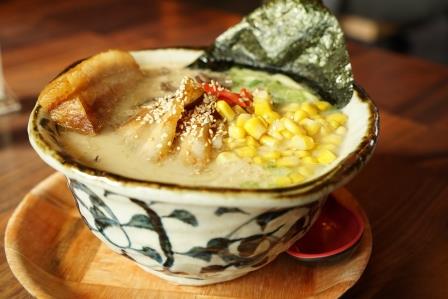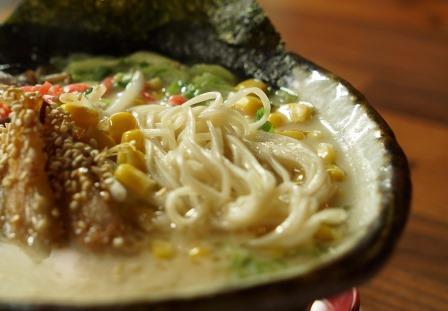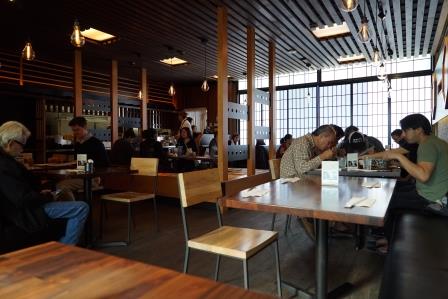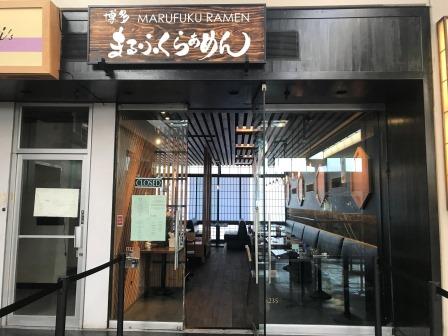Marufuku “Hakata ramen” breaking in to Japan Town of San Francisco
By Elli Sekine
A new ramen phenomenon is happening again in San Francisco’s Japan Town, a highly-competitive district for ramen restaurants. Over the last few years, the popularity of “tonkotsu style ramen” has grown even bigger due to the appearance of “Mensho Tokyo,” “Ippudo”, etc. Moreover, a Hakata style ramen specialty restaurant which nobody else had the title for, called “Marufuku” opened there in February of 2017. Hakata style ramen is new to Americans, and it is attracting a lot of attention. Ever since the opening day, people have been forming a long line to taste their soulful bowls of ramen. What is the difference between
“tonkotsu style” and “Hakata style”? There was a record showing that tonkotsu style ramen was born in “Hakata” Fukuoka, the place of origin, in 1941.
It is said that the tonkotsu style ramen began as follows: some noodles were used to be served as the last ingredient of the “Hakata nabe” a chicken stock based hot pot dish. Then, tonkotsu (pork bone based stock) was added to the soup, and Chinese noodles were thrown in the soup to be combined, and form the “tonkotsu ramen.”
Back then, there were no buildings in the Hakata district like now, and ramen which was served at the street carts by the river is the origin of “Hakata ramen.” The soup served then was mostly murky-white and rich, but light tasting tonkotsu-based, and the noodles were the very thin, straight kind, and topped with Hakata benishoga (red ginger shreds). After the war (1945), due to the idea that ramen was for bluecollar workers, the noodles were very thin for quick cooking, and a small amount was served at a time to retain the texture, and more noodles (kaedama) could be ordered to be added to the soup while you eat. This tradition still continues until this day. Now, in Fukuoka’s ramen restaurants, it is very common that you can select your favorite hardness of the noodles from extra hard to extra soft by adjusting the duration of cooking time. Variation of ramen styles such as “Kumamoto ramen”, “Kurume ramen”, etc., have been born in various.
Kyushu areas since, but “Hakata ramen” has been the favorite soul food for the people of Hakata through the ages. Meanwhile, the broth, which used to be so simple, the quality of the noodles, and the toppings have been perfected, but who could imagine that Hakata ramen would become a gourmet food known to the world like now? “Marufuku” which challenges itself at the reproduction of such Hakata style ramen, is a very important restaurant in the Bay Area.
“Marufuku” heavily values “teamwork” to run the restaurant. They have a purpose which is “to offer uncompromising genuine ramen to create a huge boom” in the Bay Area where cutting-edge information transmission is launched, and major IT companies such as Google and Apple have settled in. They built the foundation of the team by hiring someone who has extensive experience in working in the ramen industry, both in Japan and Los Angeles, to become the manager. The restaurant is located on the second floor of the Kinokuniya Building, which is an ideal place. After many trials and errors, the very first Hakata ramen specialty restaurant in San Francisco, “Marufuku” opened in 2017. The Hakata style, which was new to the US, was well received by the local Americans, and “Marufuku” quickly became very successful.
I recommend “HAKATA DX” ($14.99) first. Their proud soup which has been slowly cooked for 20 hours defines its Hakata style taste by the added housemade special sauce. You never get tired of its rich, deep, yet light tasting soup. The volume is perfect, and served in a classy milky-color bowl made by a Japanese craftsman, which gives a nice contrast. The extra-thin straight noodles specially ordered from a local noodle maker, are original and hard to find anywhere else. The noodles mix and match well with the soup.
The Hakata style tradition, kaedama, can be ordered for $2 each, which allows you to enjoy the noodles at their best texture until the end. Rich topping selections include large pork kakuni, flavor enhanced boiled eggs, corn, cloud ears, mushrooms, and Hakata benishoga (red ginger shreds). Other menu items include “Hakata Tonkotsu” ($10.99), “Chicken Paitan” ($10.99), “Chicken Paitan DX” ($14.99), etc. The Paitan ramen dishes are so popular, and about 30% of the customers order them. However, for the multi-cultured San Francisco, they also pay special attention to some customers who do not eat pork for religious reasons. One of the popular toppings, the juicy kakuni, can be ordered separately as an a-la-carte menu item as Kakunidon (bowl) ($7).
The drink menu includes draft beers, shochu, Japanese sake, etc. At night time, more customers drink sake, but the rotation is rather quick. However, you need to be aware that some waiting is inevitable on weekends.
“Marufuku” is striving to make a strong team by raising the motivation of the staff members who have various backgrounds and share this strong belief, that “a strong enough wish can surely be conveyed to our customers, overcoming language or nationality barriers.” I would like to see “local” food cultures spread in the way that this restaurant is doing, which offers ramen that is customized to the local area.
「博多ラーメン」がSF日本町でブレーク中!
ラーメンの激戦区、サンフランシスコ日本町にまた新たなラーメン現象が起こっている。
この2、3 年、「豚骨ラーメン」は「Mensho Tokyo」や「Ippudo」の出現で益々その人気は高まっている。しかし、まだ誰も看板をあげてない博多ラーメン専門店の「Marukufu」が2017 年2 月、日本町に新開店した。アメリカ人にはまだ聞きなれない「Hakata」スタイルは話題を呼び、その新食感を味わおうと、オープン以来、長蛇の列ができている。
「豚骨ラーメン」と「博多ラーメン」の違いは何だろう。発祥の地、「博多」(福岡)の街でとんこつラーメンが生まれたのは1941 年という記録がある。元々は鶏ガラ出汁の「博多鍋」のシメとして登場した麺は、その後豚骨を加えたスープに中華麺と組み合わせたのが「豚骨ラーメン」の始まりと言われている。
当時博多地区には今のようなビル群は無く、川端の屋台で作られていたラーメンが「博多ラーメン」オリジナルだ。白濁色でコクがあるあっさりした豚骨スープが多く、極細麺ストレートに博多紅生姜を加えたのが主な特徴。戦後(1945 〜)、労働者向けの食事だったことから、麺のゆで時間が少ない細麺が使われたが、麺がすぐ伸びてしまうため少量に盛り、替え玉(麺だけ食べている途中に追加する)を注文する習慣が今でも続いている。
今では麺の固さも客の好みに応じて「バリカタ」から「バリヤワ」まで茹で時間を変えるのも福岡のラーメン店では一般的。その後九州各地で豚骨は「熊本ラーメン」や「久留米ラーメン」など何種類にも別れているが、「博多ラーメン」は時代を超え博多っ子に愛され続けた庶民食だ。今ではその素朴だったブロスと麺の質、トッピングも極められ、世界にその名を馳せるグルメ食になるとは誰が想像しただろう。その博多スタイルの再現に挑む「Marufuku」はベイエリアでも貴重な
店だ。
「Marufuku」は、“ チーム” を重視した店作りを実施している。グーグルやアップルなどの大手IT起業が集結し、最先端のグルメ情報発信基地になるベイエリアで、「妥協しない本物のラーメンを提供し、大きなブームを巻き起こしたい」という目的を持ち、日本とトサンゼルスでラーメン修行をした豊富な経験を持つ人材をマネージャーに起用し、チームの枠組を作った。場所は紀伊國屋ビルの2階という絶好の場所。あらゆる試行錯誤を繰り返し2017年、サンフランシスコで初めてとなる「博多ラーメン」専門店、「Marufuku」をオープンした。まだアメカでは新しい博多スタイルは、地元アメリカ人に受け入れられ、開店まもなく繁栄店となった。
メニューの中で一番おすすめは「HAKATA DX」。($14.99)自慢のスープは、20 時間じっくり煮込んだものに、自家製の特性タレが「博多味」を決定付ける。リッチで味わい深いのにあっさりしているので飽きのこない味だ。日本の職人による上品な和噐に白濁色が映え、量も丁度良く盛られている。ローカルの製麺所に特別オーダーして製麺された極細ストレート麺は、他の店ではなかなか味わえないオリジナル。スープとの愛称が良く絡みやすい。博多ラーメンの伝統である替玉も$2で追加することができる為、最後までコシのある麺が味わえる。
トッピングは大きなサイズの豚の角煮、味たまご、コーン、きくらげ、マッシュルームに博多紅生姜などボリュームたっぷりの内容。メニューにはその他、「Hakata Tonkotsu]($10.99), 「ChikenPaitan]($10.99)「Chikin paitan DX」($14.99) などがある。客の約3割が注文しているというパイタンラーメンも人気がある他、多文化社会のサンフランシスコで宗教上豚を食しない客への配慮もある。人気トッピングの一つであるジューシーな角煮は、角煮丼($7)の単品メニューもある。ドリンクメニューには、ドラフトビール、焼酎、日本酒などを揃えている。夜は酒を飲む客も増えるが、比較的回転は早い方だ。しかし週末になると待ち時間は覚悟した方が良い。
「Marufuku」は、「強い想いがあれば、言語や国籍を乗り越え客に伝わる」という信念を持ち、多種多様なバックグラウンドを持つ従業員のモチベーションをあげ、強いチーム作りに務めている。同店のように地方に特化したラーメンを提供する「ご当地グルメ」ブームが広がるのを期待したい。
Marufuku
1581 Webster St. Ste 235
San Francisco, CA 94115
(415) 872-9786
https://www.marufukuramen.com/
Tue.-Fri. 11:30am-2:00pm
5:30pm-9:30pm
Sat. 11:30am-3:00pm
5:00pm-9:30pm
Sun. 11:30am-3:00pm
5:00pm-9:00pm
A new ramen phenomenon is happening again in San Francisco’s Japan Town, a highly-competitive district for ramen restaurants. Over the last few years, the popularity of “tonkotsu style ramen” has grown even bigger due to the appearance of “Mensho Tokyo,” “Ippudo”, etc. Moreover, a Hakata style ramen specialty restaurant which nobody else had the title for, called “Marufuku” opened there in February of 2017. Hakata style ramen is new to Americans, and it is attracting a lot of attention. Ever since the opening day, people have been forming a long line to taste their soulful bowls of ramen. What is the difference between
“tonkotsu style” and “Hakata style”? There was a record showing that tonkotsu style ramen was born in “Hakata” Fukuoka, the place of origin, in 1941.
It is said that the tonkotsu style ramen began as follows: some noodles were used to be served as the last ingredient of the “Hakata nabe” a chicken stock based hot pot dish. Then, tonkotsu (pork bone based stock) was added to the soup, and Chinese noodles were thrown in the soup to be combined, and form the “tonkotsu ramen.”
Back then, there were no buildings in the Hakata district like now, and ramen which was served at the street carts by the river is the origin of “Hakata ramen.” The soup served then was mostly murky-white and rich, but light tasting tonkotsu-based, and the noodles were the very thin, straight kind, and topped with Hakata benishoga (red ginger shreds). After the war (1945), due to the idea that ramen was for bluecollar workers, the noodles were very thin for quick cooking, and a small amount was served at a time to retain the texture, and more noodles (kaedama) could be ordered to be added to the soup while you eat. This tradition still continues until this day. Now, in Fukuoka’s ramen restaurants, it is very common that you can select your favorite hardness of the noodles from extra hard to extra soft by adjusting the duration of cooking time. Variation of ramen styles such as “Kumamoto ramen”, “Kurume ramen”, etc., have been born in various.
Kyushu areas since, but “Hakata ramen” has been the favorite soul food for the people of Hakata through the ages. Meanwhile, the broth, which used to be so simple, the quality of the noodles, and the toppings have been perfected, but who could imagine that Hakata ramen would become a gourmet food known to the world like now? “Marufuku” which challenges itself at the reproduction of such Hakata style ramen, is a very important restaurant in the Bay Area.
“Marufuku” heavily values “teamwork” to run the restaurant. They have a purpose which is “to offer uncompromising genuine ramen to create a huge boom” in the Bay Area where cutting-edge information transmission is launched, and major IT companies such as Google and Apple have settled in. They built the foundation of the team by hiring someone who has extensive experience in working in the ramen industry, both in Japan and Los Angeles, to become the manager. The restaurant is located on the second floor of the Kinokuniya Building, which is an ideal place. After many trials and errors, the very first Hakata ramen specialty restaurant in San Francisco, “Marufuku” opened in 2017. The Hakata style, which was new to the US, was well received by the local Americans, and “Marufuku” quickly became very successful.
I recommend “HAKATA DX” ($14.99) first. Their proud soup which has been slowly cooked for 20 hours defines its Hakata style taste by the added housemade special sauce. You never get tired of its rich, deep, yet light tasting soup. The volume is perfect, and served in a classy milky-color bowl made by a Japanese craftsman, which gives a nice contrast. The extra-thin straight noodles specially ordered from a local noodle maker, are original and hard to find anywhere else. The noodles mix and match well with the soup.
The Hakata style tradition, kaedama, can be ordered for $2 each, which allows you to enjoy the noodles at their best texture until the end. Rich topping selections include large pork kakuni, flavor enhanced boiled eggs, corn, cloud ears, mushrooms, and Hakata benishoga (red ginger shreds). Other menu items include “Hakata Tonkotsu” ($10.99), “Chicken Paitan” ($10.99), “Chicken Paitan DX” ($14.99), etc. The Paitan ramen dishes are so popular, and about 30% of the customers order them. However, for the multi-cultured San Francisco, they also pay special attention to some customers who do not eat pork for religious reasons. One of the popular toppings, the juicy kakuni, can be ordered separately as an a-la-carte menu item as Kakunidon (bowl) ($7).
The drink menu includes draft beers, shochu, Japanese sake, etc. At night time, more customers drink sake, but the rotation is rather quick. However, you need to be aware that some waiting is inevitable on weekends.
“Marufuku” is striving to make a strong team by raising the motivation of the staff members who have various backgrounds and share this strong belief, that “a strong enough wish can surely be conveyed to our customers, overcoming language or nationality barriers.” I would like to see “local” food cultures spread in the way that this restaurant is doing, which offers ramen that is customized to the local area.
「博多ラーメン」がSF日本町でブレーク中!
ラーメンの激戦区、サンフランシスコ日本町にまた新たなラーメン現象が起こっている。
この2、3 年、「豚骨ラーメン」は「Mensho Tokyo」や「Ippudo」の出現で益々その人気は高まっている。しかし、まだ誰も看板をあげてない博多ラーメン専門店の「Marukufu」が2017 年2 月、日本町に新開店した。アメリカ人にはまだ聞きなれない「Hakata」スタイルは話題を呼び、その新食感を味わおうと、オープン以来、長蛇の列ができている。
「豚骨ラーメン」と「博多ラーメン」の違いは何だろう。発祥の地、「博多」(福岡)の街でとんこつラーメンが生まれたのは1941 年という記録がある。元々は鶏ガラ出汁の「博多鍋」のシメとして登場した麺は、その後豚骨を加えたスープに中華麺と組み合わせたのが「豚骨ラーメン」の始まりと言われている。
当時博多地区には今のようなビル群は無く、川端の屋台で作られていたラーメンが「博多ラーメン」オリジナルだ。白濁色でコクがあるあっさりした豚骨スープが多く、極細麺ストレートに博多紅生姜を加えたのが主な特徴。戦後(1945 〜)、労働者向けの食事だったことから、麺のゆで時間が少ない細麺が使われたが、麺がすぐ伸びてしまうため少量に盛り、替え玉(麺だけ食べている途中に追加する)を注文する習慣が今でも続いている。
今では麺の固さも客の好みに応じて「バリカタ」から「バリヤワ」まで茹で時間を変えるのも福岡のラーメン店では一般的。その後九州各地で豚骨は「熊本ラーメン」や「久留米ラーメン」など何種類にも別れているが、「博多ラーメン」は時代を超え博多っ子に愛され続けた庶民食だ。今ではその素朴だったブロスと麺の質、トッピングも極められ、世界にその名を馳せるグルメ食になるとは誰が想像しただろう。その博多スタイルの再現に挑む「Marufuku」はベイエリアでも貴重な
店だ。
「Marufuku」は、“ チーム” を重視した店作りを実施している。グーグルやアップルなどの大手IT起業が集結し、最先端のグルメ情報発信基地になるベイエリアで、「妥協しない本物のラーメンを提供し、大きなブームを巻き起こしたい」という目的を持ち、日本とトサンゼルスでラーメン修行をした豊富な経験を持つ人材をマネージャーに起用し、チームの枠組を作った。場所は紀伊國屋ビルの2階という絶好の場所。あらゆる試行錯誤を繰り返し2017年、サンフランシスコで初めてとなる「博多ラーメン」専門店、「Marufuku」をオープンした。まだアメカでは新しい博多スタイルは、地元アメリカ人に受け入れられ、開店まもなく繁栄店となった。
メニューの中で一番おすすめは「HAKATA DX」。($14.99)自慢のスープは、20 時間じっくり煮込んだものに、自家製の特性タレが「博多味」を決定付ける。リッチで味わい深いのにあっさりしているので飽きのこない味だ。日本の職人による上品な和噐に白濁色が映え、量も丁度良く盛られている。ローカルの製麺所に特別オーダーして製麺された極細ストレート麺は、他の店ではなかなか味わえないオリジナル。スープとの愛称が良く絡みやすい。博多ラーメンの伝統である替玉も$2で追加することができる為、最後までコシのある麺が味わえる。
トッピングは大きなサイズの豚の角煮、味たまご、コーン、きくらげ、マッシュルームに博多紅生姜などボリュームたっぷりの内容。メニューにはその他、「Hakata Tonkotsu]($10.99), 「ChikenPaitan]($10.99)「Chikin paitan DX」($14.99) などがある。客の約3割が注文しているというパイタンラーメンも人気がある他、多文化社会のサンフランシスコで宗教上豚を食しない客への配慮もある。人気トッピングの一つであるジューシーな角煮は、角煮丼($7)の単品メニューもある。ドリンクメニューには、ドラフトビール、焼酎、日本酒などを揃えている。夜は酒を飲む客も増えるが、比較的回転は早い方だ。しかし週末になると待ち時間は覚悟した方が良い。
「Marufuku」は、「強い想いがあれば、言語や国籍を乗り越え客に伝わる」という信念を持ち、多種多様なバックグラウンドを持つ従業員のモチベーションをあげ、強いチーム作りに務めている。同店のように地方に特化したラーメンを提供する「ご当地グルメ」ブームが広がるのを期待したい。
Marufuku
1581 Webster St. Ste 235
San Francisco, CA 94115
(415) 872-9786
https://www.marufukuramen.com/
Tue.-Fri. 11:30am-2:00pm
5:30pm-9:30pm
Sat. 11:30am-3:00pm
5:00pm-9:30pm
Sun. 11:30am-3:00pm
5:00pm-9:00pm










